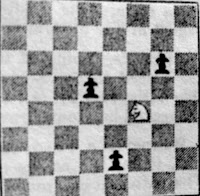Discovered check is a check that is revealed when one chess piece moves out of the way of another chess piece. The chess piece revealed is the one "in check." That means that your opponent's revealed chess piece can checkmate your King. Of course that is a good move for your opponent, and a better one if YOU use this chess tactic.
Wikipedia defines discovered check: "an attack revealed when one piece moves out of the way of another." A discovered check is also called an uncovered check. It can operate from different principles than a basic chess checkmate, as seen in the chess King moves.
 |
| 1) White Knight Shielding White King |
In the next diagram, the check is stopped by the White Bishop capturing the Black Queen.
 |
| 2) Check is stopped by White Bishop |
 |
| 3) White Pawn Covers Queens Check |
In the third diagram the pawn is right in between the White Queen on the lower left corner, and the Black King in the upper right area on the board. There is a diagonal line of attack that when the pawn moves, the Queen would be in position for the check.
When the White Pawn moves ahead one square, the Queen's position for an attack is revealed (the discovered check.) The Black King is open for an attack to be made on him by the chess Queen moves.
Next we will find out what makes a discovered check so dangerous to the defense position. In this chess tactic, if he is not protected, the King will find himself in a checkmated position.
See also 3 other kinds of Checks:
Check
Double Check
Forked Check
marblechessboard.com




























